AC Ace V8
This Chevrolet V8-engined AC Ace pre-dated the formidable Cobra by five years. Did it inspire Carroll Shelby himself?
Words IVAN OSTROFF Photography TONY BAKER
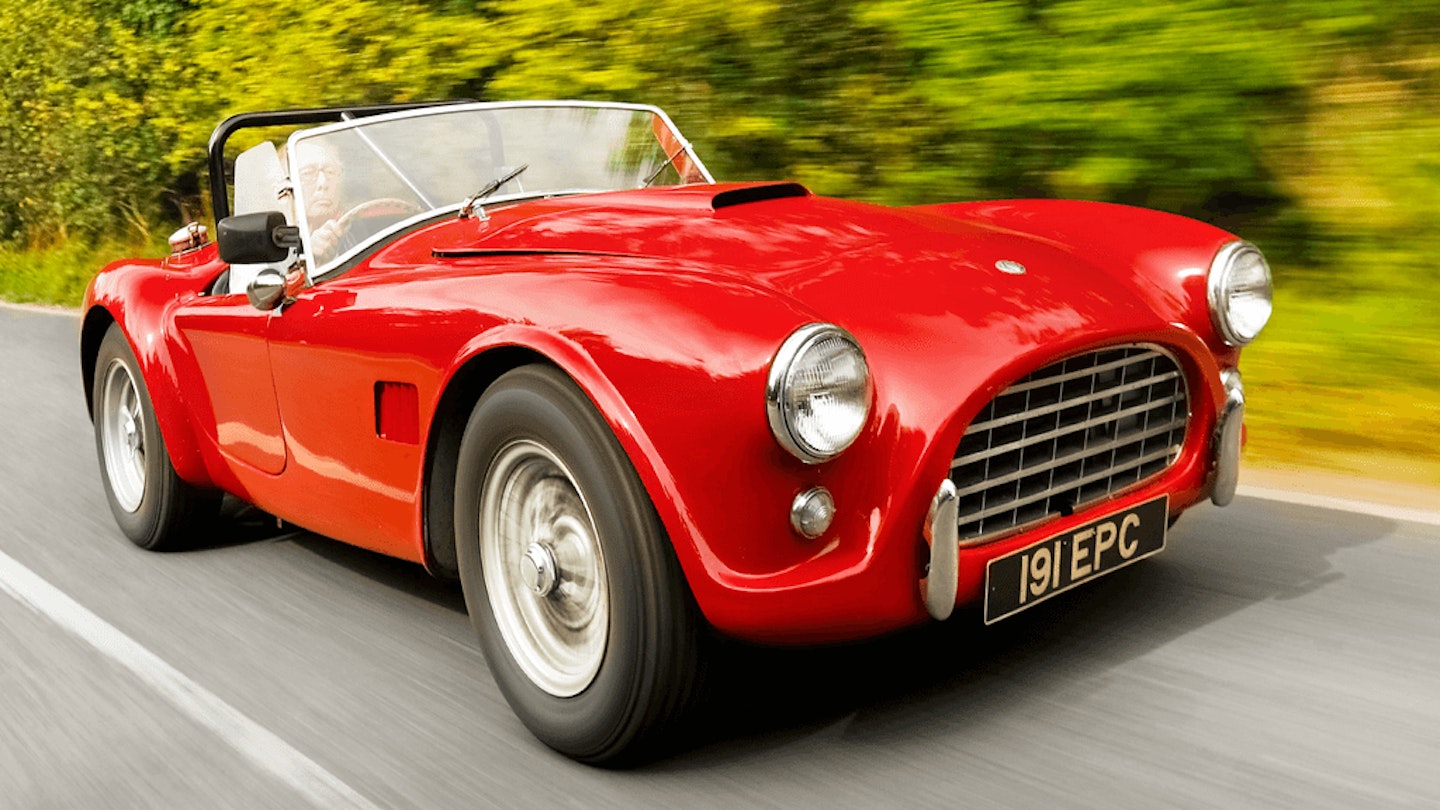
The engine is nicely warm as I change up into second gear and relish the noise of this American V8, but it takes a while for my head to get around the exhaust sound. First, I have to tell myself that this AC Ace is not powered by any of the straight sixes usually associated with the model, but an eight cylinder. Psychologically, I am expecting that Ford V8-powered Cobra noise, but that’s not here either. Instead of a wild crescendo, as the revs climb, the twin rear exhausts emit a distinctly deeper bellow.
In 1957, AC Ace chassis number BEX327 was ordered without an engine or gearbox from AC Cars for its original American owner Hubert McPhail. He had the very specific idea of dropping in a 4.3-litre Chevrolet Corvette C1 V8 engine and going racing in the US and Canada. This was five years before the AC Cobra existed, and yet the car appears to have many Cobra-like features. There is the snub nose of an Ace, but the racing filler cap is more like that of a Cobra, and there are Cobra-style slatted air vents in the wings.
‘The wood-rimmed steering wheel with its drilled alloy spokes is perfectly positioned’
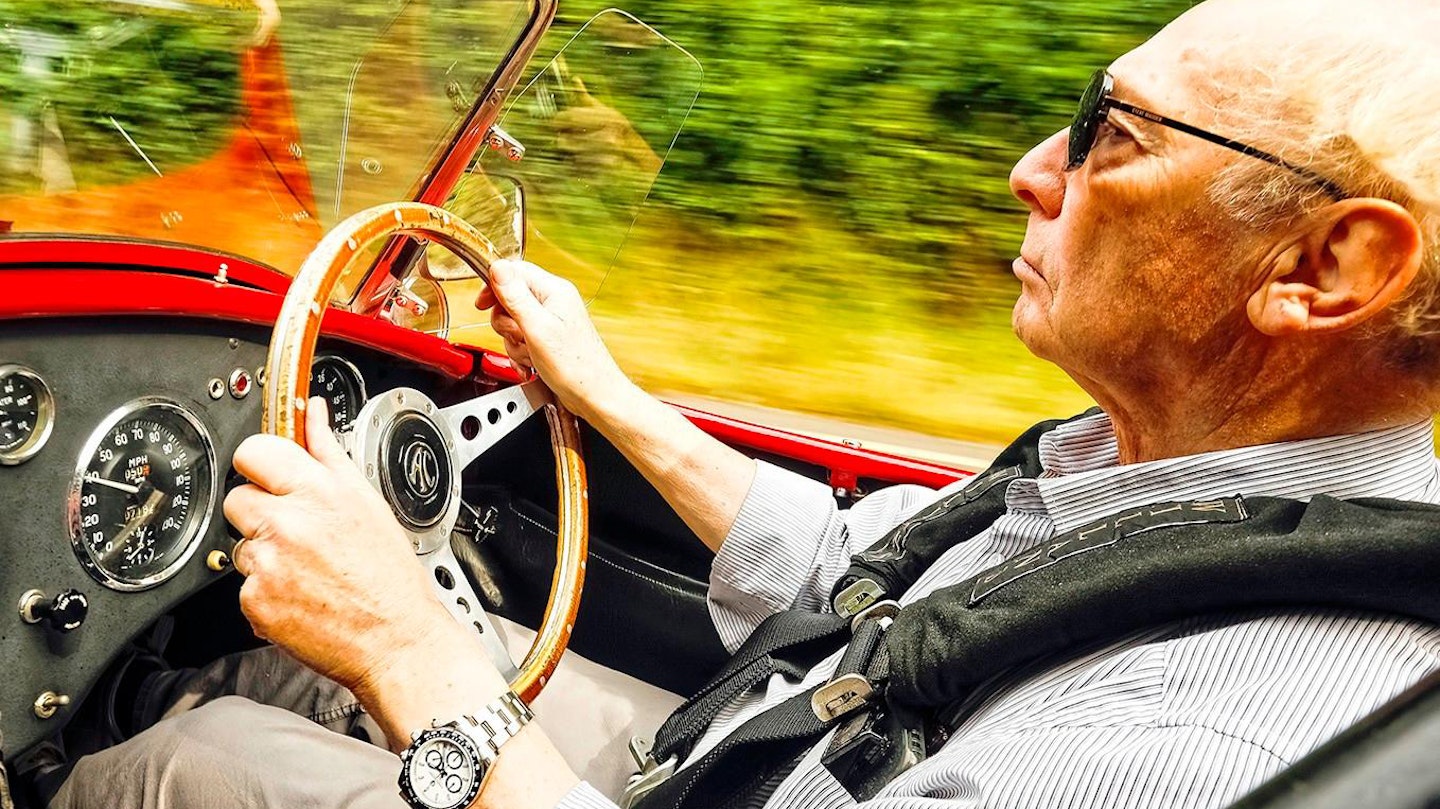
Ivan is charmed by this unique big-engined AC
Past painstaking evaluations of this car have allowed numerous experts to decide that its wheelarches are amazingly similar to a Cobra, too. Flared all-round, those at the rear have been added to cover rear tyres mounted on silver-painted, 15in knock-off wire wheels of the same size as those at the front, but with a different offset and a deeper dish so that they sit further out. At the front end, elegant extensions curve from the nose of the car over and beyond the front arches, blending gently into the front wings. All in the spirit of Cobra.
The bonnet locks are also reminiscent of early Cobras. The panel’s rear edge stands proud to allow extra airflow from the engine bay to assist cooling. Lifting the lid, instead of the expected straight-six, there is a bright, shiny V8. The tuned 5.3-litre Chevrolet unit nestles beneath a large chrome-plated air filter housing. It could be argued that as one of just three Aces exported to the US as a rolling bodyshell, BEX327 proved inspiration to Carroll Shelby to turn the Ace into the Cobra.
‘This is the most exciting AC Ace that you could possibly imagine’

Peter Knight-prepared 5.3-litre V8 has pace and tractability
With thoughts of making the Ace competitive for the contemporary Sports Car Club of America (SCCA) race series, some owners did try to install American V8 engines, but the increase in power didn’t come without its problems. The Ace chassis was built to happily accept the power from one of three straight-six engines – AC’s own 100bhp overhead-cam 2.0-litre, a 120bhp hemi-head Bristol unit or Ford’s 2.6-litre motor from the Zephyr, often tuned by Ruddspeed to 170bhp. Installing a V8 often led to flexing and twisting of the AC’s chassis because of the greater torque that was produced.
McPhail’s car was destined for the racetrack which could bring positive publicity for the UK manufacturer, even if it used a different engine or gearbox; AC Cars was happy to supply it. The Ace was imported by Joseph Hathaway ‘Hap’ Dressel – also a prominent sports car racer – of Arlington, Virginia, and soon after it arrived, it had a 4.3-litre V8 from a Chevrolet Corvette fitted. Despite the potential chassis concerns, at the time, dealer and owner must have been under the impression the Ace frame could handle the extra stresses from such power and torque.
‘When I drop down into second and press the accelerator, the V8 spins eagerly through 5000rpm’
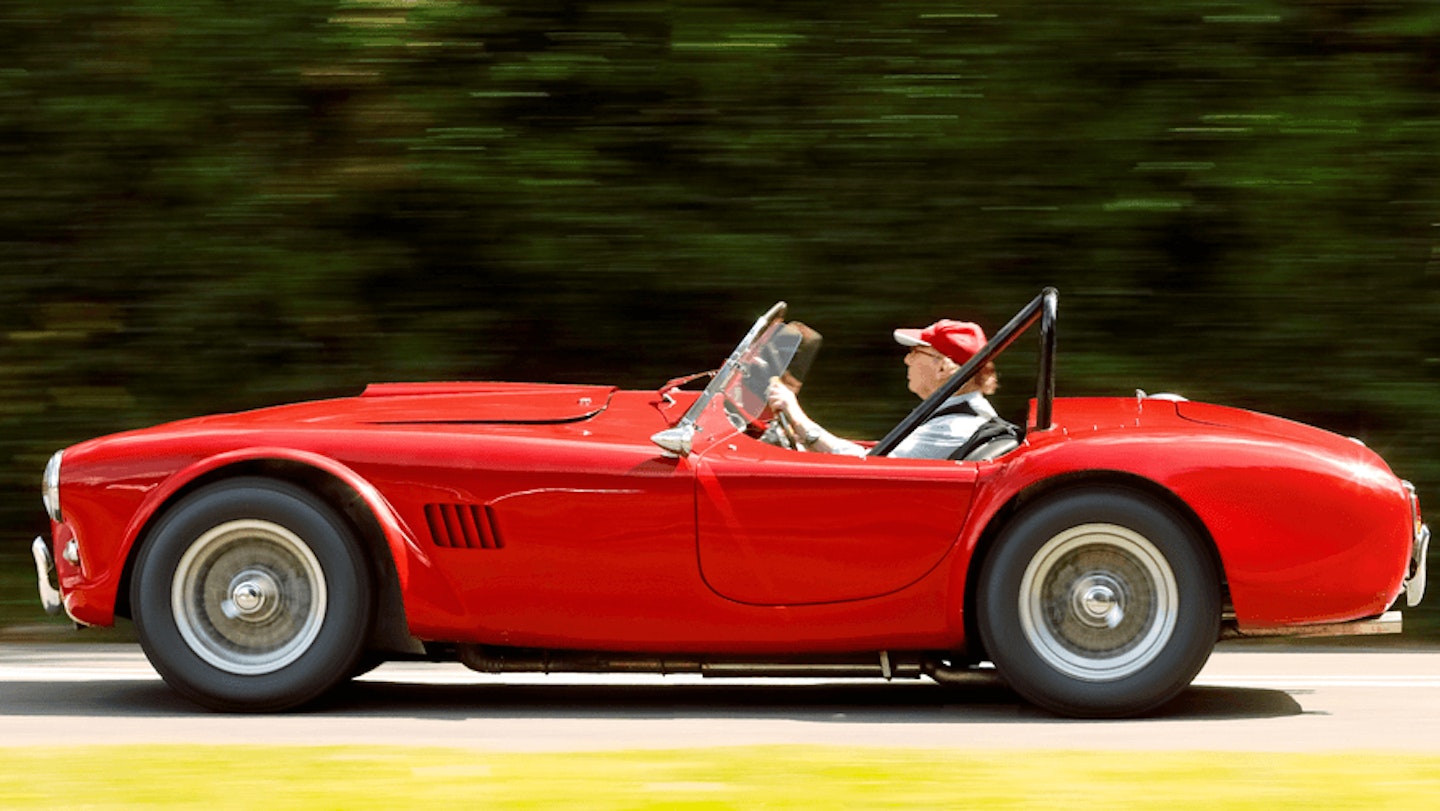
The ‘Corvace’ was put to motorsport use straight away. McPhail won a race at Harewood Acres in Canada on 26th October 1957, and after the car’s ownership passed to Warren Bush, it won again at Dunkirk, New York on 30 May 1959. Third owner Eric Schwendau bought the car for $1600 from Gorries Motors of Toronto, owning it for a short time before selling it back. Schwendau has noted to motor racing historian Rupert Lloyd Thomas in the past that the aluminium work was of an extremely high standard and, ‘better than a D-type Jaguar’. He even took the AC to a Canadian race meeting at Mosport Park, where Stirling Moss did a few test laps behind the wheel and was impressed. It was then entered into the 1964 Canadian Grand Prix by owner-racer Jack Moore, who was its last known keeper in the US. Records show that it did not arrive at the start line.

Ivan (left) discusses all things Cobra with author and fan Trevor Legate
Almost 30 years later, the Ace made its way back to the UK. Sports car enthusiast and Morgan Plus 8 owner Edward Coomber bought it in September 1992. ‘I love the torque and flexibility of a big V8, and I had always wanted an AC Cobra but couldn’t afford one. Then, while going through a copy of Motor Sport, I noticed an advert. It read, ‘AC Cobra prototype 300bhp, race modified road car, interesting history, offers over £30,000.’ I called the chap, Clive de Carle, and arranged to drive over to Berkshire with my wife to see it. I couldn’t drive it though, because the 5.7-litre V8 engine fitted had blown up, and the chassis was twisted. At least the bodywork was immaculate. De Carle said in the past someone had fitted the oil filter the wrong way round, and I will never know, but the engine was simply knackered. I had a bodywork expert take a look at it, and he confirmed that all the wheelarch extensions were aluminium, and that they had been exceptionally well done.’

Ace exported to US without engine or gearbox
Edward has gone to extraordinary lengths to establish the facts and track down the previous owners of his unique machine. John Tojeiro, who was involved in the development of the Ace with inspiration from his 1952 Tojeiro-MG Barchetta design, believed the body modifications had been carried out at the factory before the car left for the US. However, we now know that this was not so, because Edward discovered a picture of the car in America before the changes were carried out. When Tojeiro examined this car, he agreed that the work carried out on the body was of a particularly high standard, and further investigation suggests the work was carried out at by aeroplane builder in the US that was used to working with aluminium. McPhail ran a lumber yard in Kenmore, New York, but he was also a pilot and was known to work on aircraft. He also had a reputation as an aluminium craftsman.
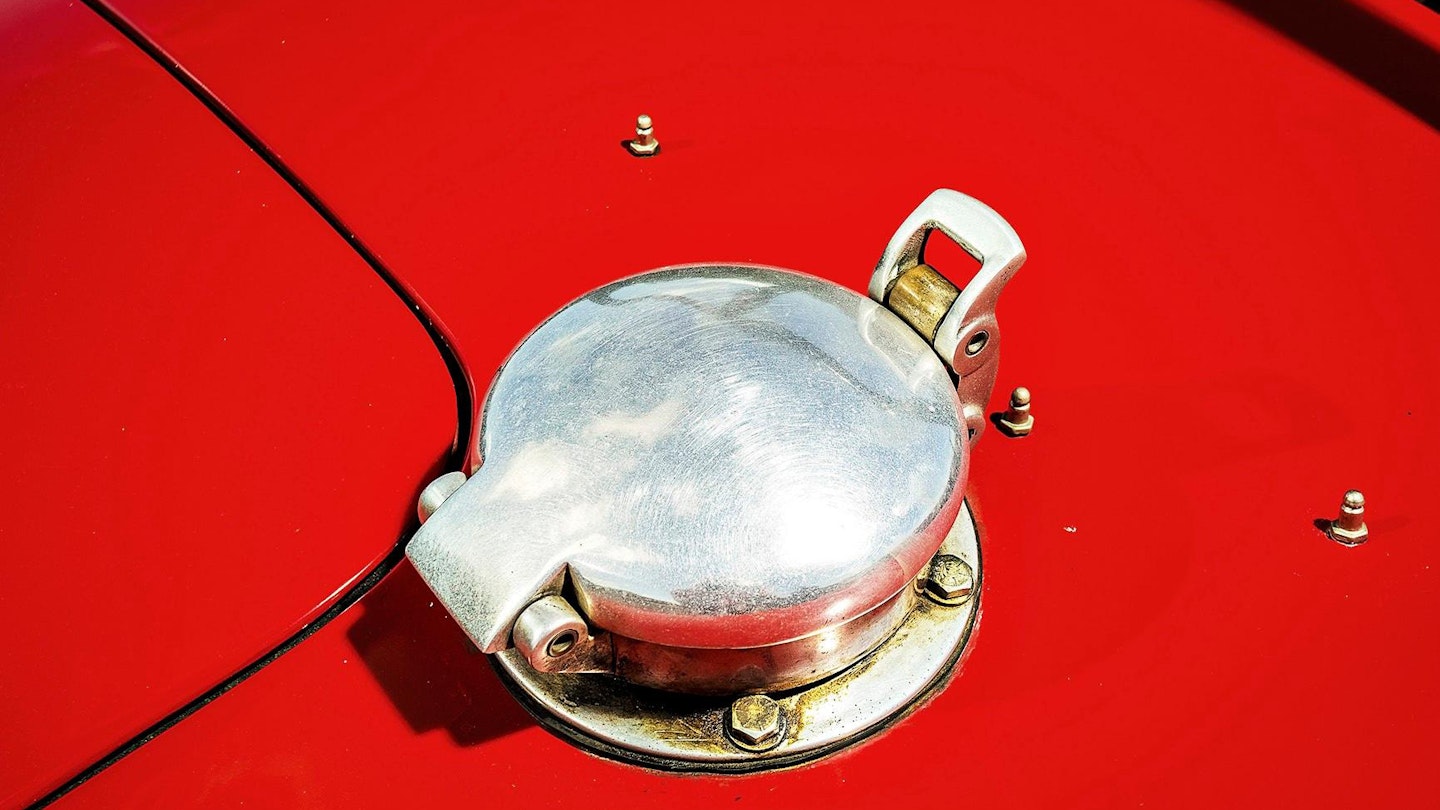
Racing career saw 40-gallon fuel tank fitted
On its return to the UK, the car was silver. Following a careful restoration by Uniclip Engineering, it is now back in its original red finish. ‘I also took off the side exhausts and tidied up the side engine vents and bonnet louvres, all of which were added at different points during the car’s racing career,’ says Edward. ‘The old Chevrolet V8 was linked to a four-speed Muncie gearbox and a limited-slip differential, and there was a 40-gallon fuel tank.
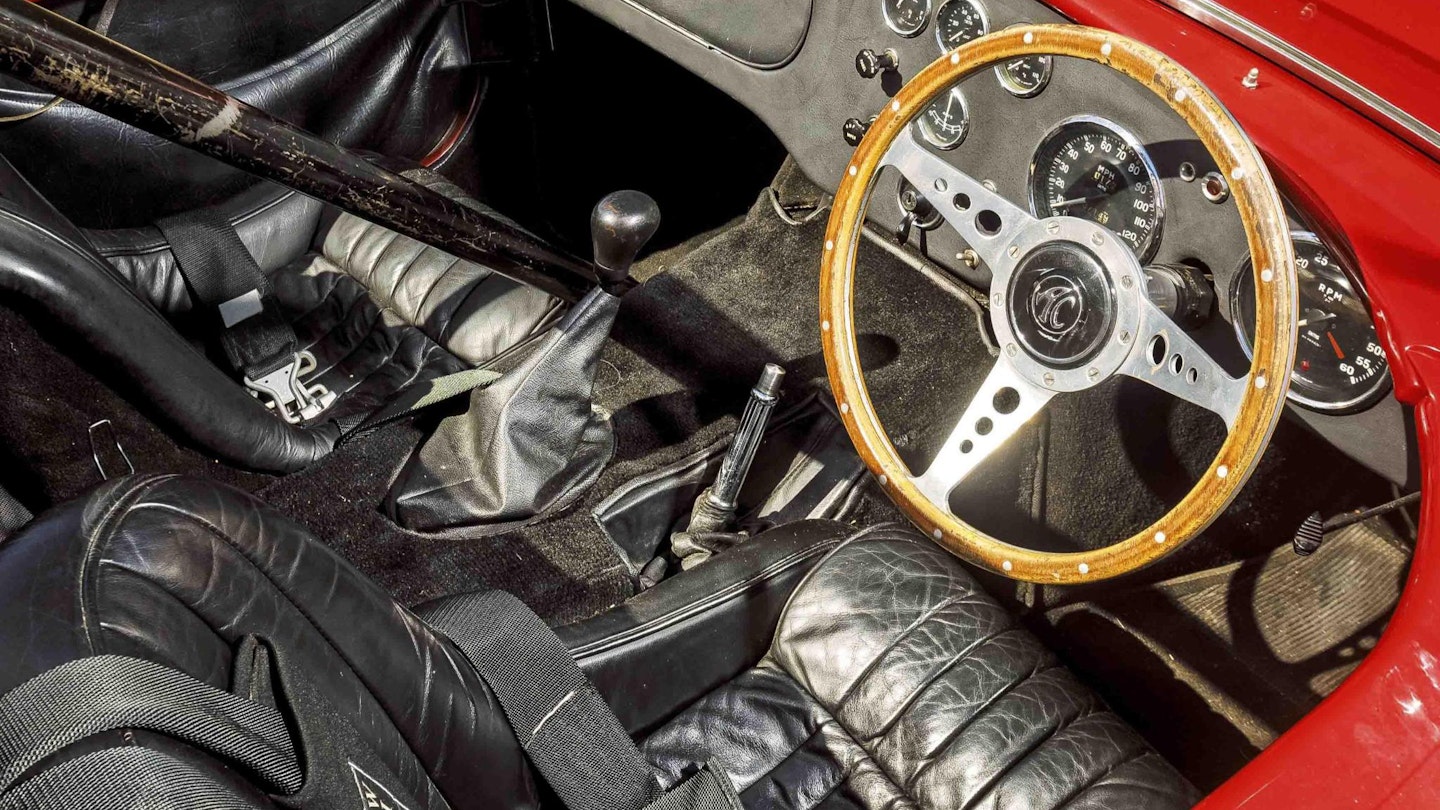
Roll-over bar hints at Ace’s competition past
‘Unfortunately, the V8 was damaged beyond economical repair, so I replaced it with a new 5.3-litre engine. This kept overheating, so I had an aluminium 5.3-litre V8 prepared by Peter Knight at Knight Racing Services Ltd with a Dart aluminium cylinder block and cylinder heads, 5700 rods, a Scat steel crank, and Wiseco forged pistons. The camshaft sits slightly higher than on the standard engine and uses a different cam journal size. Peter was unable to obtain an off-the-shelf camshaft for it, so he had to get Crower to manufacture a new one – placed 391 thou higher – for it to work in the bigger cam journals. All of this results in a very smooth eight-cylinder that delivers 300bhp at 5500rpm, and 343lb ft at 2900rpm.’
‘The exhaust emits a thrump-thrum-thrump and then settles into a smooth tick-over’
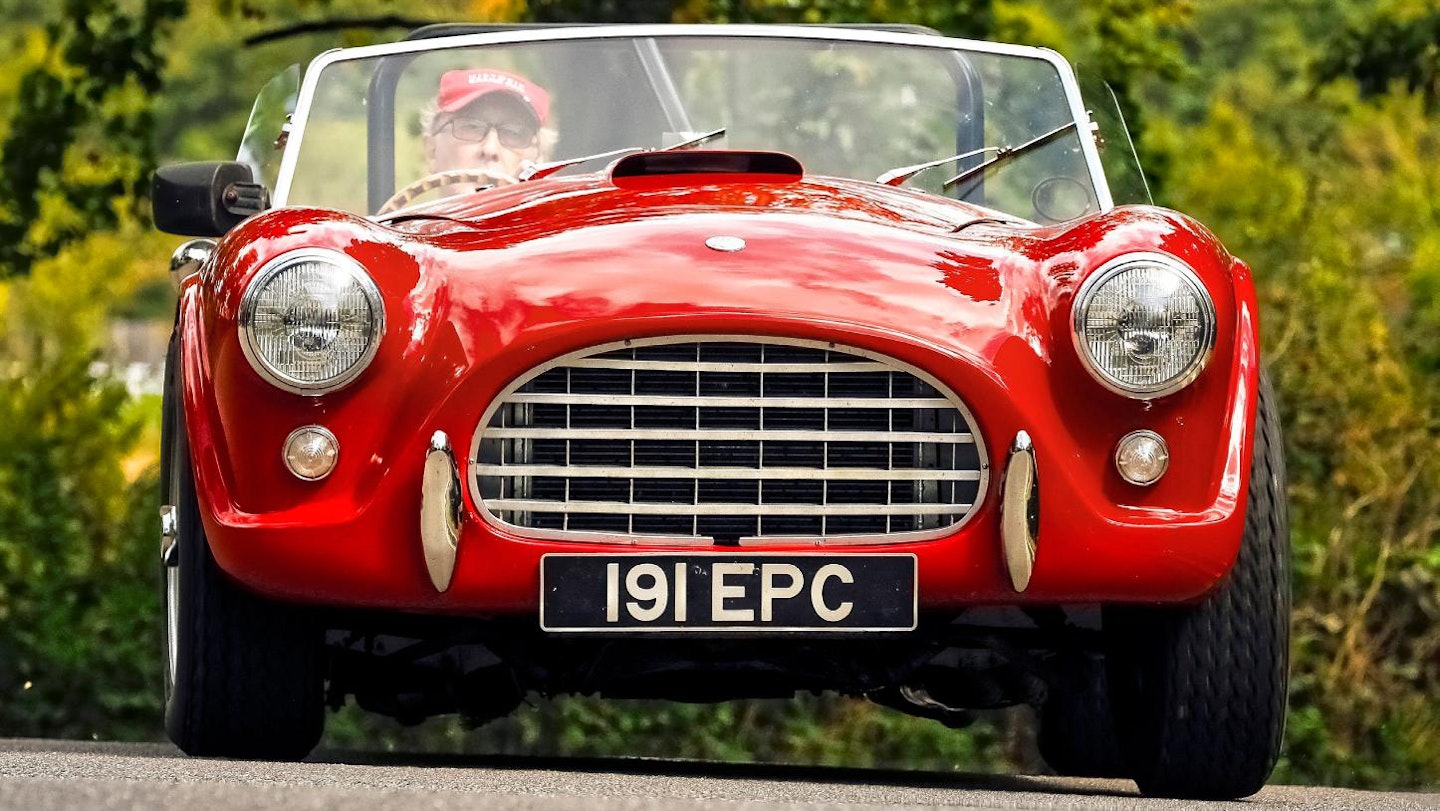
Chassis is well set up with strong levels of grip
Climbing into the big-engined Ace, I latch up the Willans safety harness and notice the reassuringly substantial black rollover bar. The large wood-rimmed steering wheel with its drilled alloy spokes and AC badge in the centre is perfectly positioned, and the instrument panel is not unlike that of a Cobra. The original Ace speedometer tops out at 130mph, very much under this car’s estimated maximum of 150mph. The tachometer reads from zero to 6000rpm with a red line at that upper limit.
Twisting the key, the starter motor churns and the engine catches almost instantly. The exhaust emits a subdued thrumpthrum-thrump pounding and then settles quickly into a mostly smooth tick-over. I push hard down on the AC-embossed aluminium clutch pedal, slip into first gear and drop the clutch. Despite the lever being cranked forward, working through the ZF five-speed gearbox is still quite an awkward reach back. Edward has obviously got used to this; a result of the engine being mounted far back in the frame.

Required body changes done exquisitely
At low revs and while not accelerating hard, the engine noise is moderate, but when I drop down into second and floor it, the V8 spins eagerly through 5000rpm, the exhaust emits a very deep growl, and 300bhp catapults 871kg of Ace forward at a thrilling rate. The 0-60 sprint is said to come up in just 4.8 seconds and I have no doubt that it does, but even in third gear, the tractability of this engine is astonishing – this is the most exciting AC Ace you could possibly imagine.
With all that torque, if you can’t be bothered to change gear, you can pop it into fifth and know it will chug happily through any town traffic, yet be up on the cam and charging off like a rocket the moment you press the accelerator.
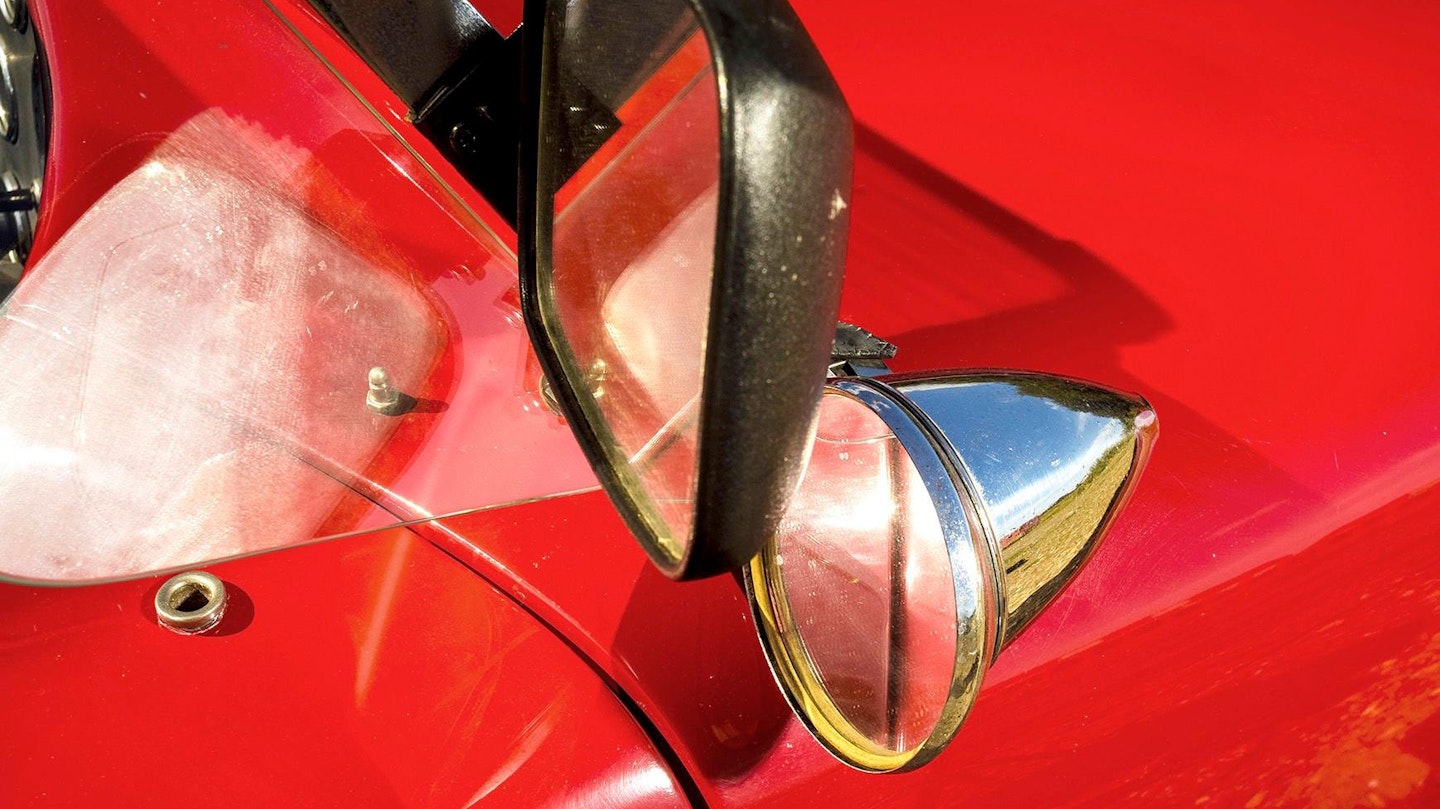
In the unlikely event someone might overtake
Approaching a tight right-hand corner, I press cautiously on the brake pedal, rewarded by a quick loss of speed. For a machine of this age, it stops very well, with good brake feel. Through the corner, there is little roll, so I prod the throttle, and try to provoke the tail to move out of line. It doesn’t – maybe the smallest of slips – so I gently prod a little more. The subtle movement of the wood rim tells my fingers the front end is gripping well, and all four corners are in good shape. On the next bend I try to get the rear to hunker down under acceleration ’Healey-like, but it doesn’t want to know. The car is well set-up and all four corners grip as it shoots forward.
This being no ordinary Ace, so long as you respect the power available, the stiffened front and rear transverse leaf springs are quite capable of handling the power, while providing a reasonable ride. It is easy to spin the wheels, but it’s reassuring that the back end does not become unruly. The wheels will spin in third if you really go for it, but the Ace never gets out of hand.
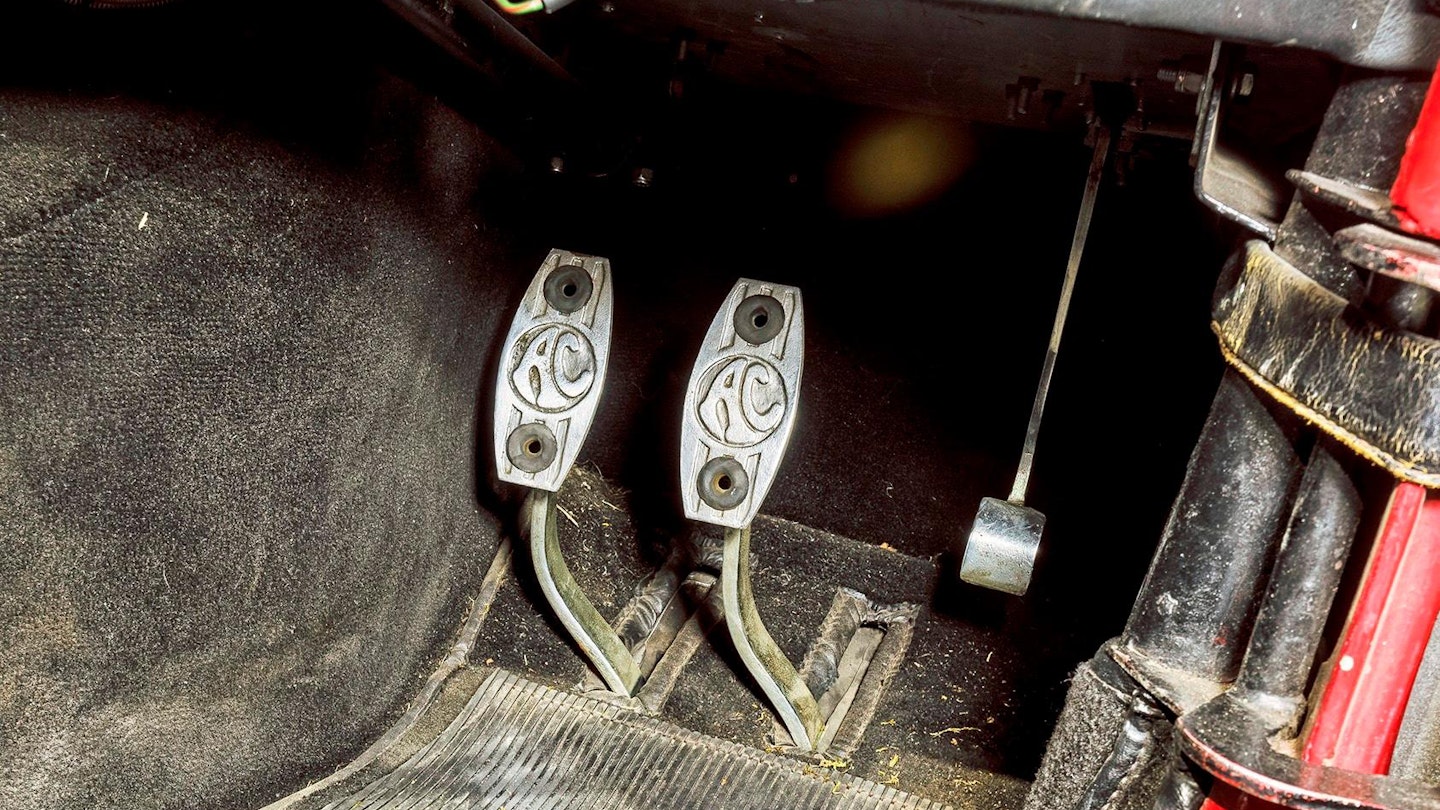
Such a small pedal; so much power to use
With its almost relentless acceleration, high levels of grip and feel, and those beautiful but more muscular looks, you can see that appeal of this special AC. ‘When I get into it, I sometimes bash my elbow on the fire extinguisher, and I curse, but despite that, I just love this car,’ says Edward.
‘The most enjoyable feature is that even though it is almost 70 years old, it’s just a delight to go back to basics and enjoy the raw sensations of a car of that period. Modern cars are soulless, but in this, I can feel absolutely everything, and it takes me back to my youth. It is, without a doubt, a true and proper driver’s car.’
I couldn’t agree more. We’ll never know if Carroll Shelby’s idea for the Cobra was borne from this car, but whatever the truth is, this is one of the most interesting and enjoyable classic cars I have ever driven.
‘Engine tractability is astonishing, and the power catapults the Ace forward at a thrilling rate’

Muscular yet modest, and very enjoyable
1957 AC Ace V8
Engine Chevrolet 5359cc V8, ohv, four-barrel Holley downdraft carburettor
Power and torque 300bhp @ 5500rpm; 343lb ft @ 2900rpm
Transmission ZF five-speed manual, rear-wheel drive
Steering Worm and sector
Suspension Front and rear: independent, transverse leaf springs, lower tubular wishbones, inclined dampers
Brakes Front and rear: discs
Performance 0-60mph: 4.8sec; top speed: 150mph (estimated)
Weight 1920lb (871kg)
Fuel consumption 14-20mpg
Cost new £2011 (1953, Bristol-engined AC Ace)
Current estimated value £400,000
OWNING AN AC ACE

‘It is so easy to drive and is not a monster that’s going to bite you,’ says owner Edward Coomber. ‘Trevor Kitney and Alan Smith at Uniclip of Byfleet, run by the Shepherd brothers, did the initial work for me over two years and made it more user-friendly. I don’t have either the courage or the skill to race, so for me it is just a very fine car to takeout for a drive.
‘Initially I spent a considerable amount on it, with the new Peter Knight engine and gearbox replacing the Chevrolet V8 and Muncie transmission. Since then, there have been no issues – the car is simply serviced and MoT’d every year and probably costs me about £1000 a year.
‘If I had to drive the Ace 100 miles in a single trip, it wouldn’t worry me because it is so rewarding. It just puts a smile on my face, and when I switch off, I always think it is such a great car. It is both easy to drive and easy to get in and out of, and I take great pleasure in the fact that I have been able to bring it back to being both usable and enjoyable.
‘I simply use it for pleasure. I pop down to the pub occasionally, and sometimes take my wife shopping, a 20-mile return journey. In total, I drive around 250 miles a year in it.’
Thanks to: Trevor Legate, author of Cobra – The First 40 Years; Rupert Lloyd Thomas, motor historian; and Debbie Delaney at SVP Motorsport.
Subscribe to Classic Cars today. Choose a Print+ Subscription and you'll get instant digital access and so much more. PLUS FREE UK delivery.
